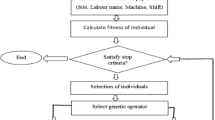Abstract
Design has always played an important role in building projects, as it affects the construction process. Selecting competent design teams is a key factor that needs to be considered for the successful completion of a design project. Applying only the limited experience and subjective judgment of humans can have a negative effect on the process of decision-making, since it is difficult to sufficiently consider all the influential factors affecting the options for a combination of teams. Therefore, it is necessary to develop an automated model to effectively support experiences and judgments of decision-makers. In this context, this paper employs Case Base Reasoning(CBR) based on the solutions of similar past cases along with Genetic Algorithm(GA) generating useful solutions through combinations of each individual. The CBR-Genetic Algorithm based design team selection model used for selecting appropriate design teams was developed in this study based on a literature review and an analysis of current selection processes. The developed CBR-Genetic Algorithm based design team selection model, which consists of Modules I and II, was then validated by comparing the results obtained from twelve experts with the results that were automatically selected by Module I and II through real case studies (50 multi-family completed apartment design projects). It was shown that the CBR-Genetic Algorithm based design team selection model is superior to current selection processes because it is able to select appropriate design teams tailored for a future project by simultaneously considering numerous criteria and a variety of combinations of design team possibilities.
Similar content being viewed by others
Reference
Ammeter, A. P. and Dukerich, J. M. (2002). “Leadership, team building, and team member characteristics in high performance project teams.” Engineering Management Journal, Vol. 14, No. 4, pp. 3–10.
Barczak, G. and Wilemon, D. (2003). “Team member experiences in new product development: views from the trenches.” R & D management, Vol. 33, No. 5, pp. 463–479.
Brandenburg, S. G., Haas, C. T., and Byrom, K. (2006). “Strategic management of human resources in construction.” Journal of Management in Engineering, ASCE, Vol. 22, No. 2, pp. 89–96.
Chen, S. J. and Lin, L. (2004). “Modeling team member characteristics for the formation of a multifunctional team in concurrent engineering.” IEEE transactions on engineering management, Vol. 51, No. 2, pp. 111–124.
Dogan, S. Z., Arditi, D., and Gunaydin, H. M. (2006). “Determining attribute weights in a CBR model for early cost prediction of structural systems.” Journal of Construction Engineering and Management, ASCE, Vol. 132, No. 10, pp. 1092–1098.
Hartenian, L. S. (2003). “Team member acquisition of team knowledge, skills, and abilities.” Team Performance Management, Vol. 9, No. 1/2, pp. 23–30.
Hecker, P. A. (1996). “Human resources strategies for successful consulting engineering firms.” Journal of Management in Engineering, Vol. 12, No. 5, pp. 32–36.
Hollenbeck, J. R. (2004). “Bridging the gap between I/O research and HR practice: improving team composition, team training, and team task design.” Human Resource Management, Vol. 43, No. 4, pp. 353–370.
Huselid, M. A. (1995). “The impact of human resource management practices on turnover, productivity, and corporate financial performance.” Academy of Management Journal, Vol. 38, No. 3, pp. 635–672.
Ireland, V. (2004). “Improving staff performance.” Construction Management and Economics, Vol. 22, No. 2, p. 121.
Koo, C. W. (2007). A CBR-based hybrid model for predicting construction duration and cost based on project characteristics in multi-family housing project, Master Thesis, The University of Seoul, Seoul, Korea.
Lyons, P. (2006). “Team member involvement in team leader training and performance.” Team Performance Management, Vol. 12, No. 3/4, pp. 102–114.
Mendelsohn, R. (1997). “The constructability review process: A constructor’s perspective.” Journal of Management in Engineering, ASCE, Vol. 13, No. 3, pp. 17–19.
Morley, M. and Heraty, N. (1995). “The high-performance organization: developing teamwork where it counts, Management Decision.” Quarterly Review of Management Technology, Vol. 33, No. 2, pp. 56–63.
Piczak, M. W. and Hauser, R. Z. (1995). “Self-directed work teams; a guide to implementation.” Quality Progress, Vol. 29, No. 5, pp. 81–88.
Rosen, R. H. (1991). The healthy company: Eight strategies to develop people, productivity, and profits, St. Martin’s, New York.
Scarnati, J. T. (2001). “On becoming a team player.” Team Performance Management, Vol. 7, No. 1/2, pp. 5–10.
Stoy, C. and Schalcher, H. R. (2007). “Residential building projects: Building cost indicators and drivers.” Journal of Construction Engineering and Management, ASCE, Vol. 133, No. 2, pp. 139–145.
Zaltman, G., LeMasters, K., and Heffring, M. (1982). Theory construction in marketing, John Wiley and Sons, New York.
Author information
Authors and Affiliations
Corresponding author
Rights and permissions
About this article
Cite this article
Park, SC., Koo, KJ. CBR-genetic algorithm based design team selection model for large-scale design firms. KSCE J Civ Eng 15, 1141–1148 (2011). https://doi.org/10.1007/s12205-011-0912-7
Received:
Revised:
Accepted:
Published:
Issue Date:
DOI: https://doi.org/10.1007/s12205-011-0912-7




